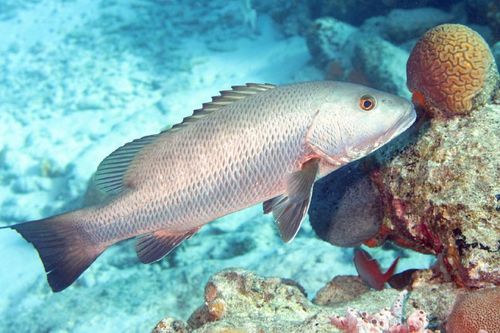
Cubera Snapper
The Bluefin Tuna (Thunnus) is a group of large, powerful, and highly migratory fish belonging to the Scombridae family. Renowned for their size, speed, and commercial value, they are apex predators in the marine ecosystem. These magnificent fish play a critical role in ocean food webs.
15 30 years
Lifespan
160 cm
Length
Vulnerable
Conservation Status
25 km/h
Swimming speed
Carnivorous
Diet
Local Migration
Migration
Appearance Overview
The Bluefin Tuna is renowned for its large, streamlined body, built for speed and endurance in the open ocean. It exhibits a metallic blue on top and a silvery-white on the bottom, providing camouflage from above and below.
Coloration
Metallic dark blue on top, silvery-white bottom
Body Shape
Torpedo-shaped, streamlined
Fins
Two dorsal fins, the first depressible; small finlets behind second dorsal and anal fins
Keel
Strong keels on the tail base
Length
Up to 10 feet (3 meters) commonly, though some can reach up to 14 feet.
Weight
Typically up to 550 lbs (250 kg), but can reach over 1,500 lbs (680 kg).
Diet
Carnivorous, feeding on smaller fish (like mackerel, herring, and sardines), squid, and crustaceans. They also consume eels and some planktonic organisms when smaller.
Feeding Behavior
Highly active predator, using speed and agility to hunt. They are opportunistic feeders and often hunt cooperatively, herding and trapping schools of fish.
Social Behavior
Generally forms schools, particularly during migrations and spawning. Schooling behavior is more pronounced in younger fish; older individuals may be more solitary.
Commercial Relevance
Extremely high value, particularly in sushi and sashimi markets, where its fatty flesh is highly prized. This demand drives significant fishing pressure.
Conservation measures
International fishing quotas, minimum size limits, time/area closures, and efforts to reduce bycatch. Organizations like ICCAT manage Atlantic bluefin tuna stocks.
Status
Varies by species: Atlantic Bluefin Tuna - Endangered, Pacific Bluefin Tuna - Near Threatened, Southern Bluefin Tuna - Critically Endangered
Threats
Overfishing is the primary threat, driven by high market demand. Other threats include bycatch in fisheries targeting other species, and habitat degradation.
Habitat Distribution
Depth Range
Primarily pelagic, inhabiting depths from the surface (0 meters) to over 1,000 meters (3,300 feet), depending on the species and time of year.
Geographic Range
Atlantic Bluefin Tuna: Western and Eastern Atlantic Ocean, Mediterranean Sea. Pacific Bluefin Tuna: North Pacific Ocean. Southern Bluefin Tuna: Southern Hemisphere oceans.
Preferred Environment
Temperate and subtropical waters; highly migratory, often found in open ocean environments but can also come closer to shore.
Reproduction and Life Cycle
Breeding Habits
Spawns in warm waters, with specific spawning grounds varying by species. Atlantic Bluefin Tuna, for example, has two main spawning areas: the Mediterranean Sea and the Gulf of Mexico.
Development Stages
Eggs are pelagic (float in the open water). Larvae hatch and feed on plankton, growing rapidly. Juveniles form schools and gradually mature into adults.
Fecundity
Highly fecund; a single female can produce tens of millions of eggs per spawning season, although survival rates of eggs and larvae are low.
Maturity Age
Varies by species. Atlantic Bluefin Tuna typically mature between 4-8 years, while Southern Bluefin Tuna may take longer.
Faqs about Cubera Snapper
How far do Bluefin Tuna migrate?
Bluefin tuna are highly migratory, capable of crossing entire oceans. They travel to specific spawning grounds and follow prey availability.
What is the lifespan of a Bluefin Tuna?
Bluefin tuna can live up to 40 years, though this varies by species and environmental conditions.
Are Bluefin Tuna warm-blooded?
Yes, they are warm-blooded, which allows them to maintain a higher body temperature than the surrounding water, giving them advantages in speed and endurance.
How fast can Bluefin Tuna swim?
Bluefin tuna are among the fastest fish in the ocean, capable of bursts of speed up to 40-60 mph.
Which organizations are responsible for managing Bluefin Tuna populations?
ICCAT (International Commission for the Conservation of Atlantic Tunas) is the primary body responsible, along with regional fisheries management organizations.
Can Bluefin Tuna survive in cold water?
Bluefin tuna have a unique ability to regulate their body temperature, a rete mirabile system, allowing them to thrive in a wider range of water temperatures.
Where do Bluefin Tuna spawn?
They spawn in specific areas like the Mediterranean Sea and the Gulf of Mexico (for Atlantic Bluefin). Spawning occurs in warm waters.
Why are Bluefin Tuna endangered?
Overfishing has dramatically reduced their populations, making sustainable fishing practices crucial for their survival.
Copyright @ Nature Style Limited. All Rights Reserved.
 English
English